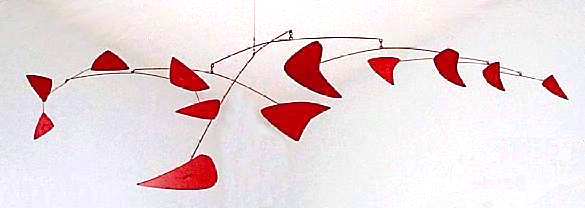Mobile (sculpture) on:
[Wikipedia]
[Google]
[Amazon]
 A mobile (, ) is a type of
A mobile (, ) is a type of
Alexander Calder's Mobiles
by
 A mobile (, ) is a type of
A mobile (, ) is a type of kinetic sculpture
Kinetic art is art from any medium that contains movement perceivable by the viewer or that depends on motion for its effects. Canvas paintings that extend the viewer's perspective of the artwork and incorporate multidimensional movement are ...
constructed to take advantage of the principle of equilibrium. It consists of a number of rods, from which weighted objects or further rods hang. The objects hanging from the rods balance each other, so that the rods remain more or less horizontal. Each rod hangs from only one string, which gives it the freedom to rotate about the string. An ensemble of these balanced parts hang freely in space, by design without coming into contact with each other.
Mobiles are popular in the nursery, where they hang over cribs to give infant
In common terminology, a baby is the very young offspring of adult human beings, while infant (from the Latin word ''infans'', meaning 'baby' or 'child') is a formal or specialised synonym. The terms may also be used to refer to juveniles of ...
s entertainment and visual stimulation
Stimulation is the encouragement of development or the cause of activity in general. For example, "The press provides stimulation of political discourse." An interesting or fun activity can be described as "stimulating", regardless of its physic ...
. Mobiles have inspired many composer
A composer is a person who writes music. The term is especially used to indicate composers of Western classical music, or those who are composers by occupation. Many composers are, or were, also skilled performers of music.
Etymology and def ...
s, including Morton Feldman and Earle Brown who were inspired by Alexander Calder's mobiles to create mobile-like indeterminate pieces. John Cage
John Milton Cage Jr. (September 5, 1912 – August 12, 1992) was an American composer and music theorist. A pioneer of indeterminacy in music, electroacoustic music, and Extended technique, non-standard use of musical instruments, Cage was one ...
wrote the music for the short film Works of Calder that focused on Calder's mobiles. Frank Zappa
Frank Vincent Zappa (December 21, 1940 – December 4, 1993) was an American guitarist, composer, and bandleader. In a career spanning more than 30 years, Zappa composed Rock music, rock, Pop music, pop, jazz, jazz fusion, orchestra ...
stated that his compositions employ a principle of balance similar to Calder mobiles.
Origin
The meaning of the term "mobile" as applied to sculpture has evolved since it was first suggested by Marcel Duchamp in 1931 to describe the early, mechanized creations of Alexander Calder. At this point, "mobile" was synonymous with the term "kinetic art", describing sculptural works in which motion is a defining property. While motor- or crank-driven moving sculptures may have initially prompted it, the word "mobile" later came to refer more specifically to Calder's free-moving creations. Calder in many respects invented an art form where objects (typically brightly coloured, abstract shapes fashioned from sheet metal) are connected by wire, much like abalance scale
A scale or balance is a device used to measure weight or mass. These are also known as mass scales, weight scales, mass balances, massometers, and weight balances.
The traditional scale consists of two plates or bowls suspended at equal dis ...
. By the sequential attachment of additional objects, the final creation consists of many balanced parts joined by lengths of wire whose individual elements are capable of moving independently or as a whole when prompted by air movement or direct contact. Thus, "mobile" has become a more well-defined term with its origin in the many such hanging constructs Calder produced in a prolific manner between the 1930s and his death in 1976.
Similar works
Calder's work is the only one defined by the term "mobile"; however, three other notable artists worked on a similar concept.Man Ray
Man Ray (born Emmanuel Radnitzky; August 27, 1890 – November 18, 1976) was an American naturalized French visual artist who spent most of his career in Paris. He was a significant contributor to the Dada and Surrealism, Surrealist movements, ...
experimented with this idea around 1920, Armando Reverón who during the 30s made a series of movable skeletons and Bruno Munari created his "Useless Machines" in 1933, made in cardboard and playful colors.Munari, Bruno: ''Air Made Visible'', 288 pages, Lars Müller Publishers, 2001. Also Julio Le Parc, Grand Prize winner at the Venice Biennale in 1966.
See also
* Dreamcatcher * Stabile (disambiguation) * Straw mobile * Suncatcher * Wind chimeReferences
External links
Alexander Calder's Mobiles
by
Jean-Paul Sartre
Jean-Paul Charles Aymard Sartre (, ; ; 21 June 1905 – 15 April 1980) was a French philosopher, playwright, novelist, screenwriter, political activist, biographer, and literary criticism, literary critic, considered a leading figure in 20th ...
, '' Les Temps Modernes'', 1963
{{Authority control
Types of sculpture
1931 introductions
Motion (physics)